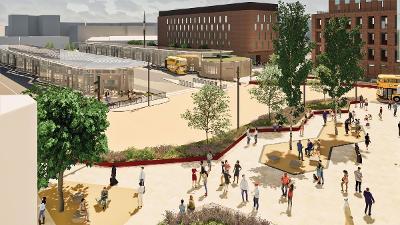Demolition work to begin in March kick-starting a year of visible change and renewal in St Helens town centre
Demolition work to make way for St Helens town centres' multi-million-pound transformation will begin in March, kick-starting a year of highly visible change and renewal, St Helens Borough Council has confirmed.

Article date: February 11th 2025
Vinci Building, working on behalf of St Helens Borough Council and its development partner ECF, will begin the staged process of demolishing vacant, acquired buildings around the existing St Helens Bus Station from 10 March 2025.
The move will prepare the ground for work to begin on building the new St Helens Transport Interchange and Gamble Square, in advance of the existing bus station fully closing in Spring and the new Temporary Bus Hub at Chalon Way becoming operational.
The majority of bus services will remain unchanged when these initial works begin, but from 3 March 2025 - one week before demolition work begins -there will be some small changes to where passengers catch their bus at the bus station, to allow early progress to be made on the once-in-a-lifetime regeneration initiative.
From 3 March 2025 Stands 1, 2 and 3 in the existing St Helens Bus Station will no longer be in use. Services that currently operate from these stops will instead be reallocated and depart from alternative stands within the bus station, or from an additional temporary stand that will be introduced on Bickerstaffe Street.
A full list of the services impacted by this change is available at: https://www.merseytravel.gov.uk/travel-updates/st-helens-bus-station-stands-1-2-and-3/
Passengers are advised to plan ahead, leave more time for their journey and check timetables. They should also regularly check operator websites and social media for the latest information about bus services.
The new St Helens Transport Interchange is to be built on an extended footprint of the current bus station and will better connect St Helens' bus and rail services with improved walking and cycling links, creating a greener, more accessible and high quality, future-proofed hub for bus passengers in the heart of the town centre. The project is being delivered with £32m of funding from the Liverpool City Region Combined Authority, and funding from the Towns Fund.
The project is set for completion in 2026, coinciding with the introduction of the first franchised bus services in St Helens. To be rolled out across the city region by the end of 2027, the new franchised network will allow greater local control of fares, timetables and routes.
Councillor Richard McCauley, Cabinet Member for Inclusive Growth & Regeneration, said: "A huge amount of work has already taken place across St Helens town centre to facilitate earliest delivery of our ambitious transformation plans - including the diversion of existing utility apparatus and creating essential new electricity infrastructure, clearing vacant buildings and construction work for the Temporary Bus Hub. But these forthcoming demolition works are set to be the most visible sign of progress so far and the exciting things to come.
"This year will see a vast amount of change and progress made towards our goal of a renewed and vibrant town centre. We remain committed to working with our partners at ECF, Vinci Building and the Liverpool City Region Combined Authority to keep the town centre residents, visitors, businesses and the travelling public well informed and to minimise disruption."
The new St Helens Transport Interchange is just one element of the first phase of the £100m regeneration of St Helens. The wider plans will transform 24-acres of the town centre with a new Market Hall, flanked by a mixed-use area set around a 120-bedroom Hampton by Hilton hotel, 64 stunning new homes, and 11,000 sq ft of modern retail space, along with extensive high quality public spaces.
St Helens Borough Council and ECF entered into a 20-year partnership focused on the transformation of St Helens Borough with the first key focus being the transformation of Earlestown and St Helens town centres.




